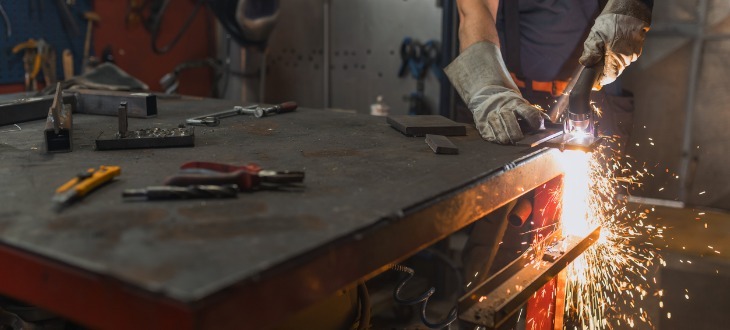Plasma cutting is one of the most efficient and precise ways to cut metal, offering unmatched accuracy and speed for everything from large industrial projects to detailed custom designs. However, as powerful as plasma cutting tools are, they also present unique safety risks that demand proper handling, protective equipment, and preparation.
Whether you’re using a CNC plasma cutter in a fabrication shop or working with a professional metal processing service, understanding plasma cutting safety is essential to preventing injuries and maintaining quality results.
What Is Plasma Cutting?
Plasma cutting uses an electrically conductive gas — typically compressed air, oxygen, or nitrogen — to cut through metal. When heated to extremely high temperatures (up to 30,000°F), the plasma arc melts the metal and blows away the molten material, leaving behind a clean, precise edge.
Modern CNC plasma cutting systems take this a step further by automating the process. They can produce consistent, complex cuts with tight tolerances, all while reducing human error and improving safety through better control.
Understanding the Risks of Plasma Cutting
Despite its precision, plasma cutting can pose several hazards if not handled correctly. Recognizing these risks is the first step to avoiding accidents.
- Burns and heat exposure:
The plasma arc can reach temperatures hotter than the surface of the sun. Without proper protective gear, even brief exposure can cause severe burns. - UV and infrared radiation:
The plasma arc emits intense light that can damage your eyes and skin — much like welding arcs. Unprotected exposure can result in flash burns or long-term eye damage. - Electrical shock:
Because plasma cutters use high voltage and current, electrical safety is critical. Moisture, damaged cables, or poor grounding can all increase the risk of electric shock. - Fumes and gases:
Cutting metals releases airborne particles, smoke, and gases that can be hazardous when inhaled. Poor ventilation may cause respiratory issues or dizziness. - Fire Hazards:
Molten metal and sparks can ignite nearby materials, especially in areas with oil, dust, or flammable liquids. Keeping a clean, organized workspace is essential to safety.
Fire hazards:
The right personal protective equipment (PPE) can significantly reduce risk and keep operators safe. Every plasma cutting setup should include:
- Welding helmet or face shield with proper shading to protect against UV and infrared light.
- Flame-resistant clothing, such as leather aprons or cotton welding jackets, to prevent burns.
- Safety gloves designed for plasma or welding work to protect from heat and electrical hazards.
- Steel-toed boots to shield feet from falling metal or sparks.
- Safety goggles or glasses under the face shield for extra eye protection.
- Respirators or fume extractors to limit exposure to airborne contaminants.
- Hearing protection in high-noise environments.
Proper PPE not only prevents injury but also improves comfort and focus — both essential for precision cutting.
Safety Tips and Accident Prevention Measures
Beyond personal protection, safe plasma cutting depends on strong operational habits and proper workspace management.
1. Maintain a Clean and Organized Work Area
- Remove flammable materials, oil, or debris from your cutting area. Sparks can travel several feet, so keep your surroundings clear and dry.
2. Inspect Equipment Regularly
- Check cables, hoses, and torches before every use. Look for cracks, frayed wires, or loose connections that could create electrical hazards.
3. Ensure Proper Grounding
- Always connect the ground clamp to clean metal surfaces. Poor grounding increases the risk of shock and unstable cuts.
4. Ventilate the Workspace
- Install fume extractors, open doors and windows, or use exhaust fans to keep the air clear. This is especially important when cutting stainless steel or coated metals, which release more harmful fumes.
5. Use Correct Cutting Parameters
- Match the machine’s settings (voltage, amperage, and gas type) to the thickness and composition of the material. Incorrect parameters can cause blowback, poor cuts, or excessive dross buildup.
6. Follow Lockout and Power-Down Procedures
- Before servicing or changing consumables, make sure the power is completely off. Disconnect the machine from its power source to prevent accidental activation.
7. Never Cut Near Compressed Gas Cylinders
- Sparks or molten material can ignite gases — keep cylinders safely stored and capped when not in use.
8. Stay Focused and Never Rush
- Most plasma cutting accidents happen when operators hurry or skip steps. Take your time, double-check your setup, and stay alert.
The Safety Benefits of Working with a Professional Metal Processing Service
While many experienced fabricators operate their own cutting systems, working with a professional metal processing service can provide significant safety advantages.
At Tampa Steel & Supply, our CNC plasma cutting services are performed by trained specialists using state-of-the-art equipment in a controlled environment. Here’s why that matters:
- Consistent quality and precision: Our automated CNC systems deliver cleaner cuts with less manual handling.
- Reduced exposure: Customers avoid direct contact with high-temperature plasma or fumes.
- Regulated environment: Our facility is equipped with proper ventilation, grounding, and fire suppression systems.
- Experienced operators: Our team follows strict OSHA and industry-standard safety protocols.
By trusting your cutting needs to professionals, you can focus on design and assembly — while we handle the complex, high-heat work safely and efficiently.
Reach Out to Tampa Steel & Supply Today
Want to learn more about CNC plasma cutting safety or how professional metal processing can support your next project? Tampa Steel & Supply is here to help. Our experienced team provides expert guidance, high-quality materials, and precision cutting services tailored to your needs.
Stop by our warehouse or contact us for a quote — we’ll walk you through the process and help bring your ideas to life.
We offer a comprehensive range of steel products, custom fabrication services, and nearly 40 years of industry experience serving Tampa Bay.
Request a quote online or call Tampa Steel & Supply at (813) 241-2801.

